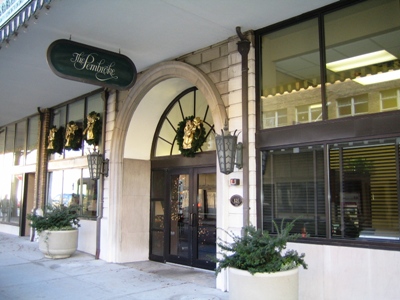 My imagination makes me human and makes me a fool; it gives me all the world and exiles me from it.--Ursula K. Le Guin |
 Union Avenue Union AvenueAn Urban Journal Exploring Place, Purpose, Literature, Memory, and This Time |
Journal Entries
| 
June 7, 2002 Must have rained in the night. This morning there is pooled water on my neighbor's rooftop outside my third-floor office window. Mourning doves are padding around and in it like late-rising women in chenille bathrobes trying to find clues to the day's direction. The front has pushed out the haze and left a perfectly blue sky with cotton puff clouds. Actually, it cleared out yesterday evening. I was sorry I didn't have my camera with me when I came out of the Knoxville Writers' Guild meeting at 8:00 and saw the town all Van Gogh pink and gold, the bell tower of Ayres Hall rising out of the treetops like a copper and ivory chess piece. A rare experience given the humidity and pollution in this river valley.
This evening I walked over the just completed Clinch Avenue bridge, renovated to accommodate the also just-completed convention center beside it and on around the art museum. Dusk, the sky to the East a deep marine blue, and the downtown in the foreground was, I have to say, quite lovely. It looked lush with trees; I could even see the pear tree on Union, an odd tree to find surrounded by asphalt.
The wall along the sidewalk between the art museum and the Candy Factory is lined with metasequoia glyptostroboides or Dawn Redwood, those wonderful tall, cone-shaped firs that came from China. They're an almost mystical tree, the needles so short and tiny that the fronds look like feathers; and it loses all of them in the winter, curious, because it looks like an evergreen but is really a deciduous coniferous. As a poet and a lover of Chinese poetry, I find them fascinating, the fact they were discovered growing in a monastery in Hunan Province and brought to this country in the mid '40s. They also grow in Hubei and Sichuan Provinces, and some there are over 450 years old. Because they thrive in remote mountain areas with moist, well-drained soil, and because Tennessee is situated on approx the same longitude and latitude as these Chinese provinces, the metasequoia also thrives here.
I first discovered them on the UT campus when I was attending graduate school; a few are scattered across the main campus, but large numbers of them can be found on the Agricultural campus. There was one beside the Humanities Bldg and that first winter when it shed its needles, I thought, assuming it was an evergreen, that it had died and was very upset that campus landscapers could have let that happen. A Botany professor soon set me straight, and, fascinated, I did further research into its history.
Having been born and raised in Appalachia, I understand why the melancholy, introspective early Chinese poetry appeals to me--the geographic similarity of our landscapes has naturally produced similar poetic sensibilities. Poet Charles Wright comes to mind; he was born in TN and lives in VA, and his poetry is very Eastern, often mentioning the Chinese poets who inspire him. A beautiful poem of his, Body and Soul which appeared in the April 8 issue of The New Yorker is a fine example. In it, he compares his existence to that of Wang Wei, a Tang Dynasty poet. So, when I look at those tall redwoods, I am transported to China, can, like Wright says, travel to the end of the earth and back without a sound.
|